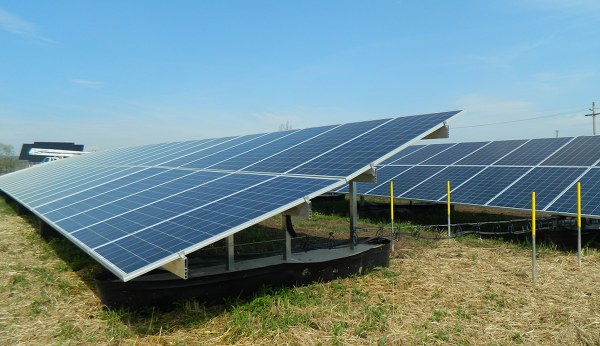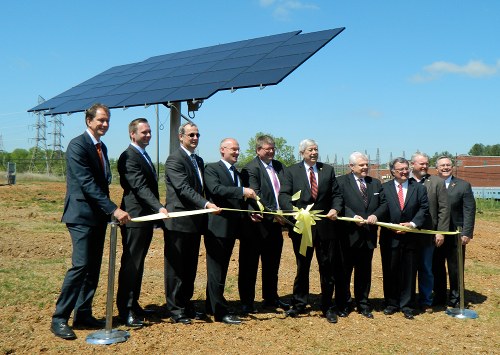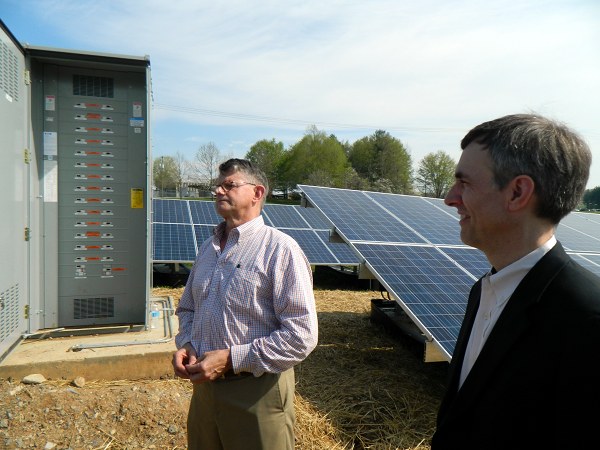
Company executives and city and federal officials celebrate a new one-megawatt solar array at Heritage Center in west Oak Ridge on Thursday with a ceremonial “plugging in.”
A new one-megawatt solar array at the Heritage Center in west Oak Ridge will provide enough clean energy to power 133 average-size homes per year, officials said.
Company and nonprofit executives joined city and federal officials for a ceremonial “plugging in” of the new Powerhouse Six photovoltaic solar array on Thursday.
The $1.8 million array has 3,268 solar modules, and it will be used to sell electric power to the Tennessee Valley Authority through the Oak Ridge Electric Department.
“We’re going live today,” said Gil Hough, renewable energy manager for RSI, or Restoration Services Inc., the Oak Ridge-based company that developed the array.
Powerhouse Six is located on a five-acre “brownfield” site that can’t be used for other development. The property, which has giant underground power conduits beneath it, was acquired under a long-term commercial lease agreement with the Community Reuse Organization of East Tennessee, or CROET. The site is near a speculative industrial building at Heritage Center.
It’s the third solar installation at Heritage Center, the former uranium-enriching K-25 site. RSI had a ribbon-cutting in May 2012 for a solar array that can generate enough electricity to power about 20 homes. That $800,000, 200-kilowatt solar farm uses four rows of south-facing panels on 1.5 acres at the front side of Heritage Center and east of Powerhouse Six. It’s called the Brightfield One Solar Array and has 828 Tennessee-made solar panels. It sells electricity to Tennessee Valley Authority through the Generation Partners program.
The second installation was announced about one year later, in April 2013. That 50-kilowatt photovoltaic solar array is also at Heritage Center, and it includes seven ground-mounted trackers that are 20 feet high. They each include 28-30 solar panels. The trackers adjust themselves to capture the most sunlight, using two sensors each to adjust from east to west and tilting up and down.
The solar panels were expected to produce an estimated 40 percent more energy than traditional ground-mounted systems or about 91,000 kilowatt-hours a year. That’s equal to the annual energy consumption of about eight average American homes.
The tracking array was a $250,000 to $300,000 investment and the first U.S. project for Vis Solis LLC of Franklin, Tennessee, a subsidiary of Vis Solis GmbH in Breesen, Germany, and the German Energy Agency, or dena.
Like Powerhouse Six, the tracking array is built on land that is not suitable for other uses and leased from CROET. The 50-kilowatt tracking array is next to the new one-megawatt Powerhouse Six array.

The Powerhouse Six solar array has 3,268 solar modules, is located on five acres at Heritage Center, and can produce 1.4 million kilowatt hours per year, or enough electricity to power 133 homes.

The Brightfield One 828-panel solar farm at Heritage Center in west Oak Ridge can generate enough electricity to power about 20 homes. This array is east of Powerhouse Six. (File photo/May 2012)

Local and state officials joined business executives and German officials at a ribbon-cutting ceremony for a 50-kilowatt photovoltaic solar array at Heritage Center in April 2013. This array is next to Powerhouse Six. (File photo)
RSI President Paul Clay said officials are working on two other one-megawatt arrays, one at the Eastbridge Business Park in Knox County and the other at Plateau Partnership Park, a partnership of Cumberland, Morgan, and Roane counties.
Thursday’s ribbon-cutting, or “plugging in,” ceremony was just a few weeks before the 45th anniversary of Earth Day.
“The legacy of Earth Day continues on,” Clay said.
Oak Ridge Mayor Warren Gooch said the Powerhouse Six project was the result of partnerships, and it helps to diversity the city’s economy and supports the city’s Climate Action Plan, helping to reduce greenhouse gas emissions through energy diversification.
Gooch said Oak Ridge has achieved platinum status in the Tennessee Valley Authority’s “Valley Sustainable Communities” program and been recognized as a Green Power Community of the Year by the U.S. Environmental Protection Agency. Oak Ridge was one of only two cities to receive the EPA award. The other was Medford, Oregon.
Clay said Powerhouse Six LLC financed the new array at Heritage Center and will derive revenue by selling power to TVA. Federal tax credits on the project expire at the end of 2016, and the project is expected to break even in about seven years, he said.
The power purchase contract is through a TVA program known as Renewable Standard Offer Solar Solutions Initiative.
Powerhouse Six is owned by Powerhouse Six LLC. Vis Solis was in charge of engineering, procurement, and construction, with LightWave Solar Inc. of Nashville as the primary subcontractor. The U.S. Department of Energy and UCOR were also involved. Heritage Center is a DOE site, and UCOR is the overall site manager and re-industrialization manager.
The re-industrialization program at Heritage Center was launched in 1996, and it focuses on the reuse of DOE’s former research and development facilities.
Steve Johnson, president of LightWave Solar, said the largest solar installation in Tennessee about seven or eight years ago was a 50-kilowatt array on Bethel Valley Road in Oak Ridge. Now, the largest is a field that includes two 20-megawatt arrays, he said.
Solar power has equipment costs just as traditional power sources do, Johnson said. But unlike most of those other sources, solar has no fuel costs and no fuel delivery costs.
And the sun is very reliable, Johnson said, producing about 1,000 watts per square meter.
Officials said Powerhouse Six will produce about 1.4 million kilowatt hours annually through the city’s electric grid.
“That is enough power to provide electricity to 133 average-size homes per year and offset greenhouse gases equal to that produced by 203 passenger vehicles per year,” a press release said.
Other benefits cited by officials at Thursday’s ribbon-cutting included:
- supporting the Oak Ridge energy parks initiative,
- supporting DOE renewable energy goals,
- providing long-term lease payments to CROET and property tax income to the city,
- offering community economic development and jobs,
- providing reuse of a brownfield parcel at a DOE site,
- demonstrating collaboration between DOE and TVA for renewable energy development, and
- supporting TVA’s renewable energy initiative.

Among those speaking at Thursday’s ceremony were RSI President Paul Clay, standing, and from left seated, Ken Rueter, UCOR president and manager; Sun Cange, manager of DOE’s Oak Ridge Office of Environmental Management; Oak Ridge Mayor Warren Gooch; and Carlos Mayer, Vis Solis president and CEO.

Pictured above are Steve Johnson, left, president of construction contractor LightWave Solar Electric LLC, and James Worden, CEO of Solectria Renewables, which provided 29 inverters to convert DC power to grid-quality AC.
Leave a Reply